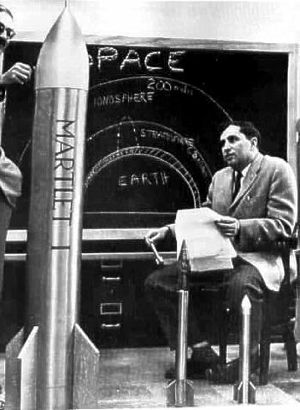
Home - Search - Browse - Alphabetic Index: 0- 1- 2- 3- 4- 5- 6- 7- 8- 9
A- B- C- D- E- F- G- H- I- J- K- L- M- N- O- P- Q- R- S- T- U- V- W- X- Y- Z
Martlet 1
 Martlet-1 |
Status: Retired 1963. First Launch: 1963-01-21. Last Launch: 1963-02-01. Number: 2 . Payload: 205 kg (451 lb). Gross mass: 205 kg (451 lb). Height: 1.78 m (5.83 ft). Diameter: 0.17 m (0.55 ft). Apogee: 27 km (16 mi).
The main body of the vehicle was intended contain colored chemicals for release during flight to produce a visible trail. This was to allow the wind and atmospheric conditions to be observed along the flight path. (primarily wind shear at altitudes near apogee). Ground observers were to determine the effect of high altitude winds on the chemical trail. The nose was designed to hold a small one watt radio telemetry transmitter and other electronic instruments.
Only four Martlet Ones were manufactured. Two were flown during the initial test series and the remaining two were retired. The first Martlet One was launched on January 21, 1963. It was launched at an elevation of 80 degrees and flew for 145 seconds. During its flight it rose to an altitude of 26 km and landed 11 km down range. The second Martlet One was launched on February 1, 1963 and flew for 146 seconds. It rose to an altitude of 27 km and landed about 11 km down range. These two flights were sufficient to prove the launch concept. The initial test series also included several wooden test slugs.
The Martlet 1 series was retired in favor of the much improved Martlet 2 family of vehicles. Also, the cost of installation of the gun and the ground support infrastructure left precious little funds for an extensive initial test series.
MARTLET ONE SPECIFICATIONS
- Mass: 205 kg (450 lb.)
- Body Diameter: 0.168 m (6.6 inches)
- Length: 1.78 m (70 inches)
- Sabot: Metallic pusher plate with four laminated plywood centering petals; outside diameter of sabot 0.417 m (16.4")
- Gun Launcher: 16.4" L45 smooth-bored gun. This was a standard 16" battleship gun which had the rifling bored out. Propellant load 330 kg cordite.
by Richard K Graf
Payload: 205 kg (451 lb) to a 27 km altitude. Launch Price $: 0.003 million in 1962 dollars. Total Development Built: 4.
Family: Gun-launched. Country: Canada. Agency: Bull.
1962 June - . LV Family: Martlet. Launch Vehicle: Martlet 1.
- Martlet One Flight Vehicle designed - . Nation: Canada. This was the first generation test vehicle for the HARP project..
1963 - . LV Family: Martlet. Launch Vehicle: Martlet 1.
- Martlet One Flight Vehicle designed. - .
Nation: Canada.
The Martlet One Flight Vehicle was designed in mid-1962 as a first generation test vehicle for the HARP project. The primary role of the Martlet One was to test the fundamental technologies for the concept. The main body of the vehicle was intended contain coloured chemicals for release during flight to produce a visible trail. This was to allow the wind and atmospheric conditions to be observed along the flight path. (primarily wind shear at altitudes near apogee). Ground observers were to determine the effect of high altitude winds on the chemical trail. The nose was designed to hold a small one watt radio telemetry transmitter and other electronic instruments.
Only four Martlet Ones were manufactured. Two were flown during the initial test series and the remaining two were retired. The first Martlet One was launched on January 21, 1963. It was launched at an elevation of 80 degrees and flew for 145 seconds. During its flight it rose to an altitude of 26 km and landed 11 km down range. The second Martlet One was launched on February 1, 1963 and flew for 146 seconds. It rose to an altitude of 27 km and landed about 11 km down range. These two flights were sufficient to prove the launch concept. The initial test series also included several wooden test slugs.
The Martlet 1 series was retired in favour of the much improved Martlet 2 family of vehicles. Also, the cost of installation of the gun and the ground support infrastructure left precious little funds for an extensive initial test series.
MARTLET ONE SPECIFICATIONS
- Mass: 205 kg (450 lb.)
- Body Diameter: 0.168 m (6.6 inches)
- Length: 1.78 m (70 inches)
- Sabot: Metallic pusher plate with four laminated plywood centring petals; outside diameter of sabot 0.417 m (16.4')
- Gun Launcher: 16.4 inch L45 smooth-bored gun. This was a standard 16 inch battleship gun which had the rifling bored out. Propellant load 330 kg cordite.
by Richard K Graf
- Mass: 205 kg (450 lb.)
1963 January 21 - . LV Family: Martlet. Launch Vehicle: Martlet 1.
- Martlet 1 Shot 1 - . Nation: Canada. Agency: HARP. Apogee: 26 km (16 mi). The gun-launched rocket was shot at an elevation of 80 degrees and flew for 145 seconds. During its flight it rose to an altitude of 26 km and landed 11 km down range..
1963 February 1 - . LV Family: Martlet. Launch Vehicle: Martlet 1.
- Martlet 1 Shot 2 - . Nation: Canada. Agency: HARP. Apogee: 27 km (16 mi). The second Martlet One flew for 146 seconds. It rose to an altitude of 27 km and landed about 11 km down range. These two flights were sufficient to prove the launch concept. The initial test series also included several wooden test slugs..
Back to top of page
Home - Search - Browse - Alphabetic Index: 0- 1- 2- 3- 4- 5- 6- 7- 8- 9
A- B- C- D- E- F- G- H- I- J- K- L- M- N- O- P- Q- R- S- T- U- V- W- X- Y- Z
© 1997-2019 Mark Wade - Contact
© / Conditions for Use